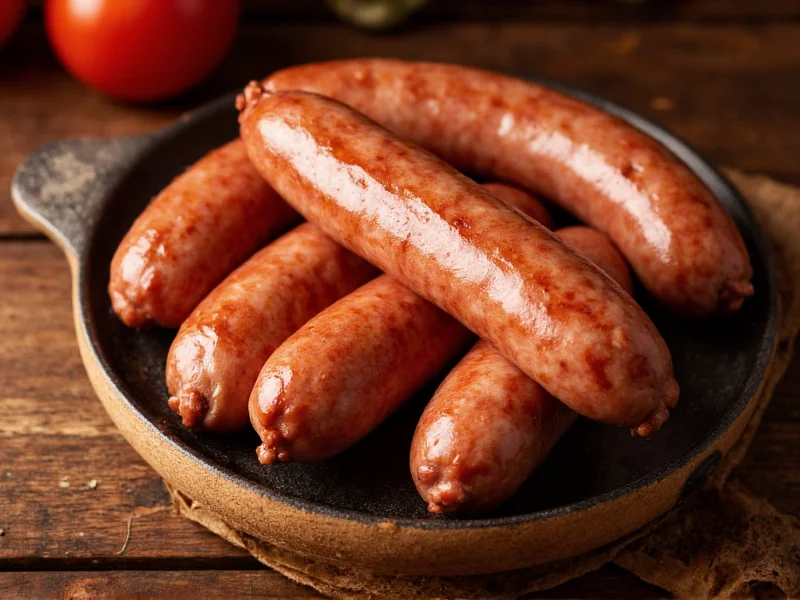Beyond Sausages represent a significant advancement in plant-based meat alternatives, developed by Beyond Meat to provide consumers with a realistic sausage experience that aligns with various dietary preferences and restrictions. Unlike traditional meat sausages, these plant-powered alternatives deliver comparable protein content while eliminating cholesterol and significantly reducing saturated fat.
Understanding Beyond Sausages Composition
The primary protein sources in Beyond Sausages come from a blend of pea protein isolate and rice protein, which work together to mimic the texture and mouthfeel of animal-based sausages. Coconut oil provides the necessary fat content that gives these plant-based alternatives their juicy quality when cooked, while beet juice extract creates the characteristic color change that occurs during cooking, similar to traditional meat products.
Additional ingredients include natural flavors, spices, and binders like methylcellulose that help maintain structure during cooking. The formulation avoids common allergens like soy and gluten, though they do contain canola oil and may have trace amounts of sesame. Each variety—whether classic breakfast, sweet Italian, or spicy—maintains a consistent nutritional profile while varying in seasoning and flavor profile.
Nutritional Comparison: Plant-Based vs Traditional Sausages
| Nutrient | Beyond Sausage (2 links) | Pork Sausage (2 links) |
|---|---|---|
| Calories | 190 | 290 |
| Total Fat | 18g | 24g |
| Saturated Fat | 6g | 8g |
| Protein | 17g | 13g |
| Cholesterol | 0mg | 60mg |
| Sodium | 550mg | 580mg |
| Fiber | 2g | 0g |
This nutritional comparison reveals important distinctions between plant-based and traditional meat sausages. While Beyond Sausages contain slightly fewer calories and eliminate cholesterol completely, they maintain comparable protein levels. The fiber content, though modest, represents an advantage over conventional sausages which contain none. Sodium levels remain similar between both options, indicating that those monitoring sodium intake should be equally cautious with either product.
Sensory Experience and Culinary Performance
When evaluating plant-based sausage alternatives, texture and cooking behavior prove as important as nutritional content. Beyond Sausages demonstrate impressive sizzle when cooked, releasing aromatic compounds that closely resemble traditional pork sausages. The casing provides a satisfying snap when bitten into, while the interior maintains a moist, crumbly texture that mimics ground meat.
Chefs and home cooks note that these plant-based alternatives perform well across various cooking methods. Pan-frying yields the best results, developing a caramelized exterior while maintaining interior moisture. The cooking time remains similar to traditional sausages—approximately 8-10 minutes over medium heat—but requires slightly more attention to prevent overcooking, which can cause the plant proteins to become tough.
Environmental Considerations of Plant-Based Sausages
Research indicates that plant-based meat alternatives like Beyond Sausages generally require significantly fewer resources to produce than conventional pork sausages. A lifecycle analysis shows plant-based options use approximately 99% less water, 93% less land, and generate 90% fewer greenhouse gas emissions compared to pork production.
These environmental benefits stem from eliminating the resource-intensive aspects of animal agriculture, including feed production, animal raising, and processing. While the manufacturing process for plant-based alternatives does require energy and processing, the overall environmental footprint remains substantially lower than traditional meat production methods.
Practical Usage and Storage Guidelines
Consumers should store unopened Beyond Sausages in the freezer until ready to use, then transfer to the refrigerator 24 hours before cooking to thaw properly. Once opened, they maintain freshness for 7-10 days when kept refrigerated in an airtight container. Freezing cooked Beyond Sausages is possible but may affect texture upon reheating.
For optimal cooking results, avoid piercing the casing during preparation, as this allows moisture to escape. Many users report best results when cooking from thawed rather than frozen, as this prevents uneven cooking. The product works well in traditional sausage applications including breakfast sandwiches, pasta dishes, and as pizza toppings, though flavor pairings should consider the slightly different fat composition compared to pork.
Who Benefits Most from Plant-Based Sausage Alternatives?
Certain dietary groups find particular value in products like Beyond Sausages. Vegetarians and vegans gain access to familiar sausage flavors without animal products. Health-conscious consumers appreciate the cholesterol-free profile and reduced saturated fat content. Those managing specific health conditions like heart disease may benefit from the improved lipid profile compared to traditional sausages.
Environmental advocates choose these products to reduce their ecological footprint without sacrificing familiar food experiences. Additionally, individuals following religious dietary restrictions that prohibit pork can enjoy sausage flavors that comply with their requirements. However, those with pea protein allergies or strict whole-food plant-based diets may need to consider alternative options.
Important Considerations for Consumers
While Beyond Sausages offer several advantages, consumers should understand they represent a processed food product. The ingredient list includes several components beyond whole food sources, which differs from minimally processed plant proteins like tofu or tempeh. Those following whole food, plant-based diets might prefer less processed alternatives.
The sodium content, while comparable to traditional sausages, remains relatively high for those monitoring sodium intake. Additionally, the product contains refined coconut oil, which provides saturated fat though at lower levels than animal-based alternatives. As with any processed food, moderation remains key within a balanced diet that emphasizes whole, unprocessed plant foods.











 浙公网安备
33010002000092号
浙公网安备
33010002000092号 浙B2-20120091-4
浙B2-20120091-4